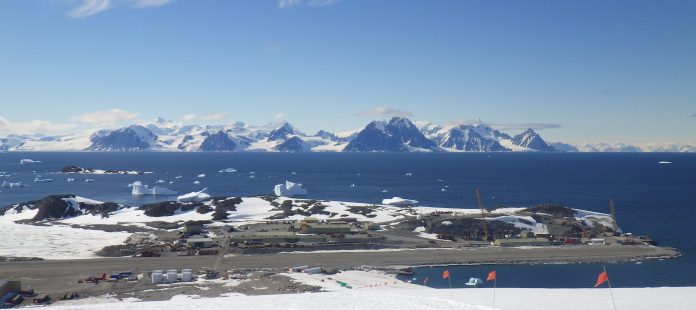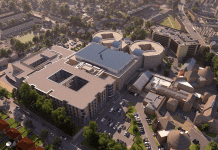A new building to facilitate the British Antarctic Survey’s (BAS) ongoing climate related research in Antarctica breaks ground today (30 January) at their largest facility, Rothera Research Station
In honour of the 200th anniversary of the first sighting of Antarctica by the British naval officer Edward Bransfield on this date in 1820, work on the new Discovery Building at Rothera Research Station has begun.
Antarctic Infrastructure Modernisation Partnership
The project is being delivered by the Antarctic Infrastructure Modernisation Partnership, which includes construction partner BAM and their team, design consultants Sweco and Hugh Broughton Architects, with Ramboll acting as BAS’s Technical Advisers, with their team NORR architects and Turner & Townsend.
Commissioned by the Natural Environment Research Council (NERC), this long-term scheme will enable a world-leading capability to ensure that Britain remains at the forefront of climate, biodiversity and ocean research in the Polar Regions.
The new operations building at Rothera Research Station, named The Discovery Building, is being delivered as part of The Antarctic Infrastructure Modernisation (AIM) Programme to update and restore infrastructure at Rothera so that it remains cost effective and safe.
The new facility will replace a series of buildings spread across the site which are outdated or costly to maintain.
The new Discovery Building at Rothera Research Station
The two-storey 4,500m2 building will accommodate preparation areas for field expeditions, a central store, medical facility, offices, recreational spaces, workshops and areas for plant. The programme of renovation commenced in 2018 with the construction of a new enlarged wharf and improvements to station infrastructure.
The Discovery Building will be under construction until 2023. All materials required to build the facility will be delivered by ship in containers and erected to a carefully managed programme which ensures the building can meet precise seasonal milestones.
BREEAM accreditation
Minimising the environmental impact of Rothera Research Station is a key part of BAS’s vision for the site. The use of a bespoke BREEAM accreditation and assessment system, developed by Ramboll in collaboration with the Building Research Establishment (BRE) to suit the special Antarctic setting, helps to ensure that the highest environmental and sustainability standards are met.
Aerodynamic design
The energy-efficient, aerodynamic design is adapted into the prevailing wind and utilises a deflector to channel air at higher speeds down the leeward face, minimising snow accumulation around the entire perimeter of the building. It is the first time a snow and wind deflector has been used at this scale in Antarctica. Ramboll has also considered the orientation of the building, using snow modelling techniques to assess its optimum position in order to mitigate the challenging Antarctic conditions.
Inspired by the Antarctic sky
A control tower protrudes from the mono-pitch roof and provides 360-degree panoramic views of the runway, wharf and station buildings. The pale blue colour of the building is inspired by the tones of the Antarctic sky; the pale colour minimises the impacts of degradation from high levels of UV, which is a feature of Antarctica. The final building envelope is formed with composite insulated metal panels and triple glazing to create an airtight and thermally-efficient enclosure, which will minimise energy use.
Interior to support well-being
An early liveability study helped inform the interior spaces based on feedback from field staff. Open-plan workspaces and break-out areas support the well-being of staff and foster collaboration.
Vibrant colours bring identity to spaces and help offset the effects of seasonal affective disorder (SAD) during the long, dark Antarctic winters. Roof lights introduce natural light into the centre of the building. Transparent glazed screens provide views between spaces to help with passive monitoring to maximise health and safety of the small crew who maintain the station in winter. Throughout the design, tried and tested plant materials and technology are used in innovative ways to ensure the building can withstand the harsh polar climate.
Jon Ager, director of the Antarctic Infrastructure Modernisation Programme, BAS, said: “This is an exciting milestone in a long-term plan to modernise Rothera Research Station.
“Once built, this new facility will enhance significantly our operational support to deep-field science campaigns.”
Graham Hopper, project director of the BAM construction partnership, said: “It is a privilege for all those involved, and testament to the hard work of all the partnership team, to be breaking ground for this state-of-the-art building, on this significant anniversary for the continent.
“The team takes great pride in being able to support BAS in continuing its pioneering science research so we can better understand our planet.”
Hugh Broughton, director, Hugh Broughton Architects, added: “This cutting-edge facility will support scientists who are investigating the impacts of climate change on our planet as we race to find solutions which will support our future.
“We are thrilled to be part of a dynamic team working with BAS to deliver the project, which will mark another important step in the development of the architecture of Antarctica.”

















